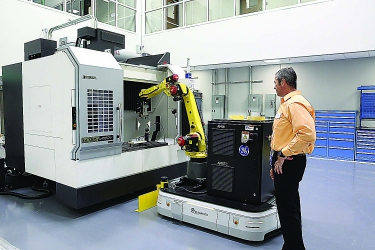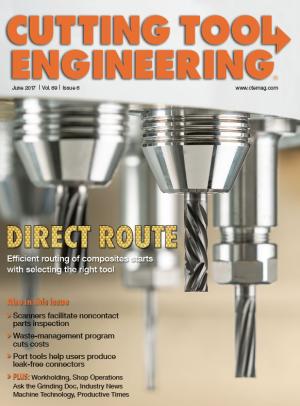GE Power opened its “Factory of the Future,” the 125,000-sq.-ft. Advanced Manufacturing Works (AMW) facility in Greenville, S.C., with great fanfare in April 2016. The result of an initial $73 million investment—with another $327 million over the next several years across the GE Power Greenville campus, where the facility resides—AMW was commissioned to drive innovation and fast development of best-in-class technologies.
So, what’s futuristic about the place? It boasts state-of-the-art manufacturing technology, including a microcutter that shines a laser beam through a thin jet of water. The jet of water focuses the beam, cools the surface of the component being cut and flushes away debris. The system, which incorporates a Synova laser, GE holemaking software and a Makino milling machine, cuts ultrahard alloys to make turbine engine parts.

GE engineer Vinson Blanton watches Autonomous Prime. The robot’s LIDAR “eyes” let it move heavy parts around the factory. Image courtesy of GE Power.
The facility also has numerous 3D printers; ovens with argon atmospheres that cure ceramic-matrix-composite (CMC) parts; and an autonomous robot (called “Autonomous Prime” after the Transformers’ character Optimus Prime). The robot navigates using LIDAR (Light Detection and Ranging), the same technology found in some self-driving cars.
Beyond the science fiction future evoked by laser beams and robots, the most forward-looking technology here may be the facility’s use of Industrial Internet of Things technology. Everything is linked by a digital thread. From design to delivery, the entire manufacturing process is connected, with monitoring and data analytics that reportedly fuel improvements at a pace undreamed of in past decades.
“The facility will revolutionize the way GE Power designs, creates and improves products by serving as an incubator for the development of advanced manufacturing processes and rapid prototyping of new parts for GE’s energy businesses,” GE Power stated in the news release that announced AMW’s grand opening. “New techniques and production processes developed at the facility will bring new best-in-class products to global customers quicker than ever.”
One year in, CTE checked with Kurt Goodwin, general manager of advanced manufacturing for GE Power, to see if the future is still as bright.
“GE’s Advanced Manufacturing Works has really progressed since the opening 1 year ago,” Goodwin said. “We’ve helped our production factories succeed in multiple areas. These include the ability to deliver optimized programs and tools for airfoil milling, as well as automated applications to help improve worker productivity for cold-metal transfer welding and grinding.
Goodwin makes it clear that the facility is more than a manufacturing-technology laboratory. Real production for real customers is being completed.
“Our first production cell for 3D printing has already delivered thousands of gas turbine parts,” Goodwin said. “It’s been a huge achievement in such little time, and we’re excited for the year ahead.”
Related Glossary Terms
- alloys
alloys
Substances having metallic properties and being composed of two or more chemical elements of which at least one is a metal.
- gang cutting ( milling)
gang cutting ( milling)
Machining with several cutters mounted on a single arbor, generally for simultaneous cutting.
- grinding
grinding
Machining operation in which material is removed from the workpiece by a powered abrasive wheel, stone, belt, paste, sheet, compound, slurry, etc. Takes various forms: surface grinding (creates flat and/or squared surfaces); cylindrical grinding (for external cylindrical and tapered shapes, fillets, undercuts, etc.); centerless grinding; chamfering; thread and form grinding; tool and cutter grinding; offhand grinding; lapping and polishing (grinding with extremely fine grits to create ultrasmooth surfaces); honing; and disc grinding.
- milling
milling
Machining operation in which metal or other material is removed by applying power to a rotating cutter. In vertical milling, the cutting tool is mounted vertically on the spindle. In horizontal milling, the cutting tool is mounted horizontally, either directly on the spindle or on an arbor. Horizontal milling is further broken down into conventional milling, where the cutter rotates opposite the direction of feed, or “up” into the workpiece; and climb milling, where the cutter rotates in the direction of feed, or “down” into the workpiece. Milling operations include plane or surface milling, endmilling, facemilling, angle milling, form milling and profiling.
- milling machine ( mill)
milling machine ( mill)
Runs endmills and arbor-mounted milling cutters. Features include a head with a spindle that drives the cutters; a column, knee and table that provide motion in the three Cartesian axes; and a base that supports the components and houses the cutting-fluid pump and reservoir. The work is mounted on the table and fed into the rotating cutter or endmill to accomplish the milling steps; vertical milling machines also feed endmills into the work by means of a spindle-mounted quill. Models range from small manual machines to big bed-type and duplex mills. All take one of three basic forms: vertical, horizontal or convertible horizontal/vertical. Vertical machines may be knee-type (the table is mounted on a knee that can be elevated) or bed-type (the table is securely supported and only moves horizontally). In general, horizontal machines are bigger and more powerful, while vertical machines are lighter but more versatile and easier to set up and operate.


